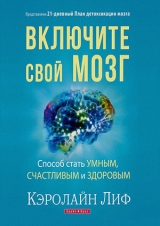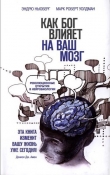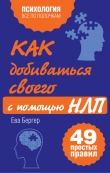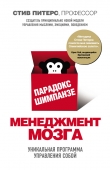
Текст книги "Включите свой мозг"
Автор книги: Кэролайн Лиф
Жанр:
Медицина
сообщить о нарушении
Текущая страница: 10 (всего у книги 10 страниц)
2012,
www.frontiersin.org/Human_Neuroscience/10.3389/fnhum.2012.00034/abstract.
[89] Eileen Luders et al., “Enhanced Brain Connectivity in Long-Term
Meditation Practitioners,” NeuroImage 4 (August 15, 2011): 1308–16.
[90] University of California, Los Angeles research cited in “Meditation May Increase Gray Matter,” Science Daily, May 13, 2009,
www.sciencedaily.com/releases/2009/05/090512134655.htm.
[91] “Max Planck Quotes,”
www.goodreads.com/author/quotes/107032.Max_Planck.
[92] Schwartz and Begley, Mind and the Brain; Schwartz and Gladding, You Are Not Your Brain; Jeffrey Schwartz, Henry Stapp, and Mario Beauregard,
“Quantum
Physics in Neuroscience and Psychology: A Neurophysical Model of
Mind/Brain
Interaction,” www.physics.lbl.gov/~stapp/PTB6.pdf.
[93] This intentional mental act and its unpredictability can be
represented
mathematically by an equation that is one of the key components of
quantum theory.
It is beyond the scope of this book to explore the equation more deeply, but if you are interested, you can begin exploring further by reading,
“Quantum Physics in
Neuroscience and Psychology: A Neurophysical Model of Mind/Brain
Interaction,”
by Jeffrey M. Schwartz, Henry P. Stapp, and Mario Beauregard,
http://www.scribd.com/doc/94124369/Quantum-Physics-in-Neuroscience-by-
Je»rey-
M-Schwartz-Henry-P-Stapp-Mario-Beuregard.
[94] James Higgo, “A Lazy Layman’s Guide to Quantum Physics,” 1999,
www.higgo.com/quantum/laymans.htm.
[95] Schwartz, Stapp, and Beauregard, “Quantum Physics in Neuroscience
and
Psychology.”
[96] Schwartz and Begley, Mind and the Brain; Schwartz and Gladding, You Are Not Your Brain; Schwartz, Stapp, and Beauregard, “Quantum Physics in Neuroscience
and Psychology.”
[97] Caroline Leaf, “The Mind Mapping Approach: A Model and Framework for Geodesic Learning,” unpublished DPhil dissertation, University of
Pretoria, South Africa, 1997; Caroline Leaf, “The Mind Mapping Approach: A Technique for Closed Head Injury,” unpublished master’s dissertation, University of Pretoria, South Africa, 1990.
[98] Carol Dweck, “Implicit Theories of Intelligence Predict Achievement Across Adolescent Transition: A Longitudinal Study and an Intervention,”
Child
Development 78 (2007): 246–63.
[99] McCraty, “Modulation of DNA Conformation by Heart-Focused
Intention,” 4.
[100] Church, Genie in Your Genes.
[101] Giacomo Rizzolatti and L. Craighero,“The Mirror-Neuron System,”
Annual
Review of Neuroscience 27 (2004): 169–92.
[102] Caroline Leaf, Who Switched O! Your Brain? Solving the Mystery of He
Said/She Said (Nashville: Thomas Nelson, 2011).
[103] Dean Radin, “Testing Nonlocal Observation as a Source of Intuitive Knowledge,” Explore 4, no. 1 (2008): 25.
[104] Thomas E. Oxman et al., “Lack of Social Participation or Religious Strength and Comfort as Risk Factors for Death after Cardiac Surgery in the Elderly,”
Psychosomatic Medicine 57 (1995): 5.
[105] Linda H. Powell et al., “Religion and Spirituality: Linkages to
Physical Health,”
American Psychologist 58, no. 1 (2003): 36.
[106] Larry Dossey, Prayer Is Good Medicine (San Francisco: HarperOne,
1997).
[107] John A. Astin et al., “The Efficacy of ‘Distant Healing’: A
Systematic Review of Randomized Trials,” Annals of Internal Medicine 12
(2000): 903; Wayne B. Jonas,
“The Middle Way: Realistic Randomized Controlled Trials for the
Evaluation of
Spiritual Healing,” The Journal of Alternative and Complementary Medicine 7, no. 1
(2001): 5–7.
[108] David Levy and Joel Kilpatrick, Gray Matter: A Neurosurgeon
Discovers the Power of Prayer ... One Patient at a Time (Wheaton, IL:
Tyndale, 2012); Matt
Donnelly, “Faith Boosts Cognitive Management of HIV and Cancer,” Science
&
Theology News (2006): 16.
[109] Levy and Kilpatrick, Gray Matter, 19.
[110] Sundance Bilson-Thompson, Fotini Markopoulou, and Lee Smolin,
“Quantum
Gravity and the Standard Model,” Classical and Quantum Gravity 24, no. 16
(2007): 3975–93.
[111] Don Lincoln, “The Universe Is a Complex and Intricate Place,”
Scientific
American, November 2012, 38–43.
[112] This is the terminology of the Heisenberg principle—quantum physics is known for its weird wording and almost ambiguous statements.
[113] Henry Stapp, “Philosophy of Mind and the Problem of Free Will in
the Light of Quantum Mechanics,” www-
physics.lbl.gov/~stapp/Philosophy.pdf; Henry Stapp,
Mindful Universe: Quantum Mechanics and the Participating Observer
(London:
Springer, 2007).
[114] Don Lincoln, “The Inner Life of Quarks,” Scientific American,
November 2012, 38.
[115] Leaf, “Mind Mapping”; Leaf, “Mind Mapping Approach”; Leaf, Louw,
and
Uys, “Development of a Model for Geodesic Learning,” 44, 53–70.
[116] Thomas More, Utopia, updated edition (London: Penguin Classics,
2003), 81.
[117] Leaf, Switch On Your Brain 5-Step Learning Process; Leaf, Who
Switched O!
My Brain?; Caroline M. Leaf, “Who Switched O! My Brain? Controlling Toxic Thoughts and Emotions,” DVD series (Johannesburg, South Africa: Switch On Your
Brain, 2007).
[118] Schwartz and Begley, Mind and the Brain.
[119] Andrew Newberg, Eugene D’Aquili, and Vince Rause, Why God Won’t Go Away: Brain Science and the Biology of Belief (New York: Ballantine,
2001).
[120] Schwartz and Begley, Mind and the Brain; Schwartz and Gladding, You Are
Not Your Brain; Schwartz, Stapp, and Beauregard, “Quantum Physics in
Neuroscience and Psychology.”
[121] Leaf, “Mind Mapping”; Leaf, “The Mind Mapping Approach”; Leaf,
Louw, and
Uys, “Development of a Model for Geodesic Learning,” 44, 53–70.
[122] Ibid.
[123] “Blue Brain Project Accurately Predicts Connections between
Neurons,”
Science Daily, September 17, 2012,
www.sciencedaily.com/releases/2012/09/120917152043.htm.
[124] Leaf, “Mind Mapping”; Leaf, “The Mind Mapping Approach”; Leaf,
Louw, and
Uys, “Development of a Model for Geodesic Learning,” 44, 53–70.
[125] Leaf, “Mind Mapping Approach: Technique for Closed Head Injury.”
[126] Karim Nader, http://blogs.mcgill.ca/science/2009/04/30/karim-nader-on-
memory-reconsolidation; Karim Nader, Glenn E. Schafe, and Joseph E. Le
Doux,
“Fear Memories Require Protein Synthesis in the Amygdala for
Reconsolidation after Retrieval,” Nature 406, no. 6797 (2000): 722–26; A.
H. Maslow, Motivation and
Personality (New York: Harper & Row, 1970).
[127] Shawn Achor, The Happiness Advantage (New York: Crown Business,
2010).
[128] Harvard Crimson poll, 2004, cited in ibid.
[129] This is 365 days in a year divided by 21 days in a cycle, which
gives you 17
cycles per year.
[130] Kandel, In Search of Memory.
[131] Church, Genie in Your Genes.
[132] Ibid.
[133] Rodolfo Llinas, “Rodolfo Llinas’s Fearless Approach to
Neurophysiology Has Redefined Our Thinking about Individual Neurons and How They Create Movement
and Consciousness,” U. S. Columbian Medical Association, http://uscma.org/2010/09/12/rodolfo-llinas’s-fearless-approach-to-neurophysiology-has-redefined-our-thinkingabout-individual-neurons-and-
how-they-create-movementand-consciousness; Rodolfo Llinas, I of the
Vortex (Cambridge, MA: MIT Press,
2002).
[134] Michael Merzenich as cited in Doidge, Brain That Changes Itself.
[135] Phillippa Lally et al., “How Are Habits Formed: Modelling Habit
Formation in the Real World,” European Journal of Social Psychology 40, no. 6 (2010): 998–1009.
[136] Ibid.
[137] See K. Anders Ericsson, Michael J. Prietula, and Edward T. Cokely,
“The
Making of an Expert,” Harvard Business Review, July 2007,
http://hbr.org/2007/07/the-making-of-an-expert/ar/1.
[138] Jennifer Wiley and Andrew F. Jarosz, “Working Memory Capacity,
Attentional Focus, and Problem Solving,” Current Directions in
Psychological Science 21, no. 4
(2012): 258. See also, “Greater Working Memory Benefits Analytic, Not
Creative, Problem-Solving,” Science Daily, August 7, 2012,
www.sciencedaily.com/releases/2012/08/120807132209.htm.
[139] “Mindfulness Meditation May Relieve Chronic Inflammation,” Science Daily, January 16, 2013,
http://www.sciencedaily.com/releases/2013/01/130116163536.htm.
[140] “Evidence Supports Health Benefits of ‘Mindfulness-Based
Practices,’” Science Daily, July 11, 2012,
http://www.sciencedaily.com/releases/2012/07/120711104811.htm.
[141] “Breast Cancer Survivors Benefit from Practicing Mindfulness-Based Stress Reduction,” Science Daily, December 29, 2011,
http://www.sciencedaily.com/releases/2011/12/111229203000.htm.
[142] “Don’t Worry, Be Happy: Understanding Mindfulness Meditation,”
Science
Daily, November 1, 2011,
http://www.sciencedaily.com/releases/2011/10/111031154134.htm.
[143] “Mindfulness Meditation Training Changes Brain Structure in Eight Weeks,”
Science Daily, January 21, 2011,
http://www.sciencedaily.com/releases/2011/01/110121144007.htm.
[144] I explain this in depth in chapter 5 (key 5) and chapter 6 (key 6).
It’s worth taking the time to look back at these chapters at this point.
[145] Caroline Leaf, The Switch On Your Brain 5-Step Learning Process
DVD/Workbook (Dallas: Switch On Your Brain, 2009).








